
Opposite the Casa Rosada on the Plaza de Mayo is the resplendent former Spanish town hall, the Cabildo, a fascinating old colonial building fronted by arches that once encircled the plaza, back during the May Revolution in 1810. While the building's construction originally began in 1610, it was almost immediately too small. Construction and changes were ongoing well into the 1800's, and the building was finally completed in 1894.The guards outside the building are members of the revered Regimiento de Patricios, which was formed in 1806, and the changing of the guard every hour is a popular attraction. They still wear the traditional uniforms they have donned for nearly 200 years.The interior houses a small museum, which displays some interesting architectural relics, religious icons and watercolour paintings by Enrique Pellegrini, and it is all furnished in colonial period pieces. The views from the Cabildo's windows are some of the best of the Plaza de Mayo. A crafts market is hosted on the back patio on Thursdays and Fridays, from 11am to 6pm.
Address : Calle Bolivar 65
Telephone : +54 11 4342 6729
Opening times : Tuesday to Friday 10am-5pm, Saturday and Sunday 10am-6pm.

One of the world's most famous balconies juts out of Argentina's Presidential Palace, known as the Casa Rosada. The pink building has been the scene of many a political rally, particularly during the regime of the notorious and tragic Juan and Eva Peron.The building began as a fort in 1594, and was turned into a castle-like centre for colonial government in 1713. Additions and changes were made to the building until 1857, when it was demolished and the Casa Rosada we know today was built. The Italian style building, fronted with palm trees and fountains, was painted pink when it was converted from a Customs and Post Office building into the presidential palace. President Sarmiento decided to appease opposing political parties by merging red and white into a pink colour scheme for the palace.The building has since been declared a National Historic Monument of Argentina. Today the building houses a small basement museum displaying some presidential artefacts. Each evening, a small platoon of mounted grenadiers emerge from the guardhouse to lower the flag on the Plaza, adding a touch of pomp and ceremony to the pretty building.
Address : Hipolito Yrigoyen 219, Plaza de Mayo
Telephone : +54 11 4344 3600
Opening times : Museum: Monday to Friday 10am-6pm, Sundays 2pm-6pm. Guided tours are available.
Admission : Free
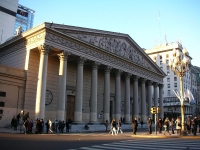
Situated in the Plaza de Mayo, the Neoclassical Cathedral Metropolitana houses the tomb of General José de San Martin, the revered hero who liberated Argentina from the Spanish. The General was originally buried in Franche, but his body was exhumed in 1880, transported to Beunos Aires and buried again, this time in a mausoleum designed by a French sculptor. The mausoleum is guarded by three sculptures, each a life-size female figure representing Argentina, Chile and Peru.The mausoleum also houses the remains of General Juan Gregorio de las Heras, General Tomas Guido, and the Unknown Soldier of the Independence. The cathedral has been periodically rebuilt and renovated since the foundation stone was laid in the 16th century. The current structure was finally completed in the mid-19th century. The interior has recently been renovated and the gilded columns, Venetian mosaic floors, and silver-plated altar are in pristine condition.Some interesting things to see in the cathedral are the two pulpits, made by the sculptor Juan Antonio Gaspar Hernandez, the director of Buenos Aires' first art school, a wide variety of colonial sculptures, a collection of very good colonial oil paintings, and the 1871 Walcker Organ containing more than 3,500 tubes, one of the finest examples of its kind.
Address : San Martin and Rivadavia streets, Plaza de Mayo
Telephone : +54 11 4331 2845
Admission : Free
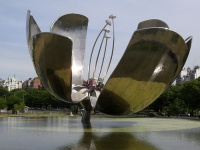
Floralis Generica is a working metal sculpture located in the United Nations square in Recoleta. Floralis Generica is composed of stainless steel, weighing 18 tons and measuring 76 feet (23m) high. It was offered to the city by Argentine architect Eduardo Fernando Catalano, who described it as an 'environmental structure'.Its metallic petals open and close based on the incidence of solar rays and visitors to the site will find the giant metal sculpture 'in full bloom' in the heat of the day and closed at night. The sheer genius and technical artistry of the giant flower makes it a sight worth seeing in Buenos Aires. The sculpture sits above a reflecting pond, adding to its charm, and the area around it has been landscaped to resemble woodlands with several paths leading to the sculpture from different directions, providing contrasting perspectives.
Address : United Nations Park, Recoleta
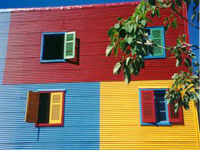
La Boca (The Mouth), situated in the south-east of Buenos Aires at the mouth of the Riachuelo river, is the most colourful neighbourhood or barrio in Buenos Aires, original home of both football legend Diego Maradona and the tango. An assortment of brightly-painted houses made of wood and metal line the streets, including the famed main street Caminito, in this poor but happy area full of artisans, painters, street performers, cantinas and open-air tango shows.The neighbourhood was originally settled by Italian immigrants from Genoa, most of whom came to work at the docks. Residents today are still mostly of European descent, from Italian, Spanish and French to German, Arab and Basque. Today it is frequented by crowds of tourists who come to soak up the lively atmosphere, watch tango dancers on the streets and squares, and sit in picturesque cafes sipping coffee and beer.La Boca residents are independent and fiery, as evidenced by their short-lived 1882 secession from Argentina that was immediately ended by the president. The area has been home to radical politicians over the years and saw many demonstrations during the unrest of 2001. Some places of particular interest in La Boca are La Ribera theatre, and La Bombonera, the home of the famous Boca Juniors football club.
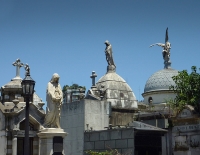
An unlikely tourist attraction, La Recoleta Cemetery is well worth visiting to see its magnificent display of monuments and the ostentatious tombs of Argentina's rich and famous. The cemetery is the second largest in the world, covering more than five hectares and filled with more than 4,700 vaults. Due to its size, the cemetery is divided into several big blocks with avenues between them, making navigation in the enormous space a little easier.Each vault has the family name carved over its entrance, while a collection of brass plaques next to the entrance displays the names of all the family members buried inside the vault. One of the more modest, but by far the most celebrated, is the grave of Eva Peron. Every day thousands of visitors come to leave flowers at the door of the Duarte family mausoleum where she is buried. Forty years on, Evita remains both the most revered and reviled figure in Argentina. Love her or loathe her, her spirit lives on in La Recoleta.In addition to Evita, another famous cemetery inhabitant is the supposed daughter of Earl Alexander Walewski, Isabel, who died in Buenos Aires when just a baby. The superstitious say that on some nights, you can hear the baby crying from her godmother's arms.
Address : Calle Junín, Plaza Francesa
Opening times : Open daily. Guided tours are available.
Admission : Free
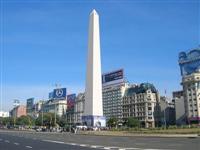
At 416 feet (127m) wide, spanning the width of an entire city block, Avenida 9 de Julio is claimed to be the widest avenue in the world. Named for Argentina's Independence Day, which falls on 9th July, the avenue was originally planned in 1888, but actual construction only began in 1935 after many disputes with landowners. While the initial phase opened for public use in 1937, the avenue was only fully completed in the 1960s, with the southern connections only completed after 1980.The avenue runs from the Retiro district in the north to Constitucion station in the south, roughly one kilometre to the west of the Rio de la Plata waterfront, and consists of 18 lanes of traffic, nine on each side.In the middle of the street stands a 67-metre-tall obelisk marking the heart of Buenos Aires. The obelisk is a popular photo spot, and visitors can climb to the top where they can look out over the Avenida 9 de Julio through its four observation windows. Lines B, C, and D of the Buenos Aires Metro converge at a station located on the pedestrian underpass below the obelisk, and the underpass also serves as a retail concourse.It can take quite a while to cross the avenue on street level as opposed to using the underpass, since there are traffic lights at each intersection, which can slow a pedestrian's crossing.
Address : Avenida 9 de Julio, Buenos Aires

Plaza Dorrego lies in San Telmo, the bohemian artists' quarter of Buenos Aires and the birthplace of tango. The tiny square is surrounded by elegant houses, now mostly converted into antique shops and bars whose tables overflow onto the street. There are numerous museums nearby the Plaza Dorrego worth visiting, including the Museo Histórico Nacional and the Museo de Arte Moderno.On Sundays, the plaza is the setting for the ancient flea market, the Feria de San Pedro Telmo. Though you are unlikely to discover too many bargains, you may find an interesting souvenir or two. Once the stallholders pack up their wares at 5pm, the square becomes a stage for informal tango dancing. This is as popular with the locals as it is with tourists, and even the inexperienced may be tempted to try it out.Aside from the museums, flea markets and dancers, another of the square's main attractions is simply the people watching. Visitors to Buenos Aires will not regret an afternoon spent whiling away the hours at a sidewalk cafe, soaking in the atmosphere and admiring the passers-by until the dancers arrive for the evening's festivities.
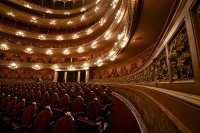
The Teatro Colón opened in 1908 and is one of the largest performing arts theatres in the southern hemisphere, second only to the Sydney Opera House in Australia. It was designed by Italian architect Francisco Tamburri and is an Italian Renaissance-style building with a seating capacity of 2,500 (although more people have been squeezed in at times). Richly decorated in scarlet and gold with frescoes lining the cupola, the theatre has hosted many international performers including Nijinsky, Pavlov, Pavarotti and Domingo, and is considered to be among the top five venues for acoustics in the world, an opinion voiced by Pavarotti amongst others.The theatre suffered during Argentina's political and economic difficulties in the 1990s and early 2000s, with attendance falling and the building suffering from neglect. However, in 2005 the theatre was completely renovated and refurbished, and reopened in 2010. In addition to hosting various concerts and performances, the theatre is also home to the Superior Arts Institution of the Teatro Colón, and guided tours take visitors to the theatre's workshops, rehearsal rooms, auditorium and stage.
Address : Cerrito 618
Website : www.teatrocolon.org.ar
Telephone : +54 11 4378 7109

Travel Guide powered by Word Travels, copyright © 2023 Globe Media Ltd. By its very nature information in this travel guide is subject to change at short notice and travellers are urged to verify information on which they're relying with the relevant authorities. Neither Globe Media Ltd nor Travel Vogue can accept any responsibility for any loss or inconvenience to any person as a result of information contained above.